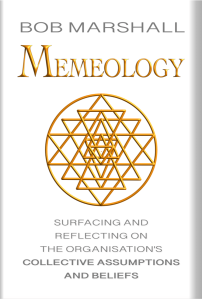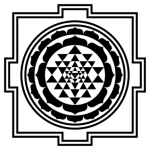Designing the Memeology Cover
Designing the Memeology Cover
I enjoy designing my own artwork and graphics for my blog posts, papers, articles, and books.
This is a short post about my design for the cover of my latest book “Memeology”
The general style (size, fonts, layout, colours) follows that of my previous Organisational Psychotherapy book “Hearts over Diamonds”:
(Note: the gradient fills to the left and right margins helps the cover stand out from white backgrounds on sites like Leanpub.)
The cover for Memeology differs from Hearts Over Diamonds mainly in the central image.
The image is inspired by the ancient mystical diagrams (yantra) used in the Shri Vidya school of Hinduism. A yantra consists of nine interlocking triangles that surround a central point known as a bindu. These triangles represent the cosmos and the human body. Devotees of the Shri Yantra believe the symbol enables achieving of a higher level of consciousness, and that it confers the ability to create one’s own reality. Devotees also believe the Sri Yantra brings peace, harmony and good fortune.
I’ve adopted this image – created by myself – to stand for the natural beauty, harmony and love that I feel in regard to Organisational Psychotherapy. There’s also research suggesting the yantra helps “to bring its viewers to a more meditative state”. Appropriate, I think, for the idea of surfacing and reflecting on beliefs and assumptions.
In Sanskrit, the word “yantra” comes from the root word “yam,” which means “instrument” or “support,” and “tra,” derived from “trana,” meaning “release from bondage.” A yantra is an instrument or tool, for meditation and contemplation and supports spiritual liberation.
The Shri Yantra, called the “queen of yantras,” (rajayantra) is the symbol of the great divine mother principle, the source of all energy, power, and creativity.

The Triangles
In the Hindu tradition, the triangles of the yantra have specific associations:
Starting at the lowermost outer triangle and moving in a counterclockwise circle, these associations are: agitation, pursuit, attraction, delight, delusion, immobility, release, control, pleasure, intoxication, an accomplishment of desire, luxury, mantra, and the destruction of duality.
The next circle has the same sequence and direction, starting from the lowest triangle and moving counterclockwise. The first triangle is the giver of all accomplishments. Next is the giver of wealth. The third is the energy of activities that please all. Fourth is the bringer of all blessings. The fifth is the granter of all desires. Next is the remover of all suffering. The seventh is considered the appeaser of death. Eighth is the overcomer of all obstacles. Ninth is the bringer of beauty, and the tenth is the giver of all good fortune.
The ten smaller triangles in the third circle represent, beginning at the same, lowermost triangle and moving counterclockwise: omniscience, omnipotence, sovereignty, knowledge, destruction of all disease, unconditional support, vanquishment of all evils, protection, and the attainment of all desires. The fourth circle of triangles, again starting at the same point and moving counterclockwise, represent: sustaining, creating, dissolution, pleasure, pain, cold, heat, and the ability to choose action.
In the final inner space, the yogi or yogini visualises five arrows representing the world of the senses, a bow, representing the mind, a noose, representing attachment, and a stick, representing aversion. The central triangle is the giver of all perfection. In the middle of the central triangle is a Bindu, representing pure consciousness and the original state of being.
– Bob



